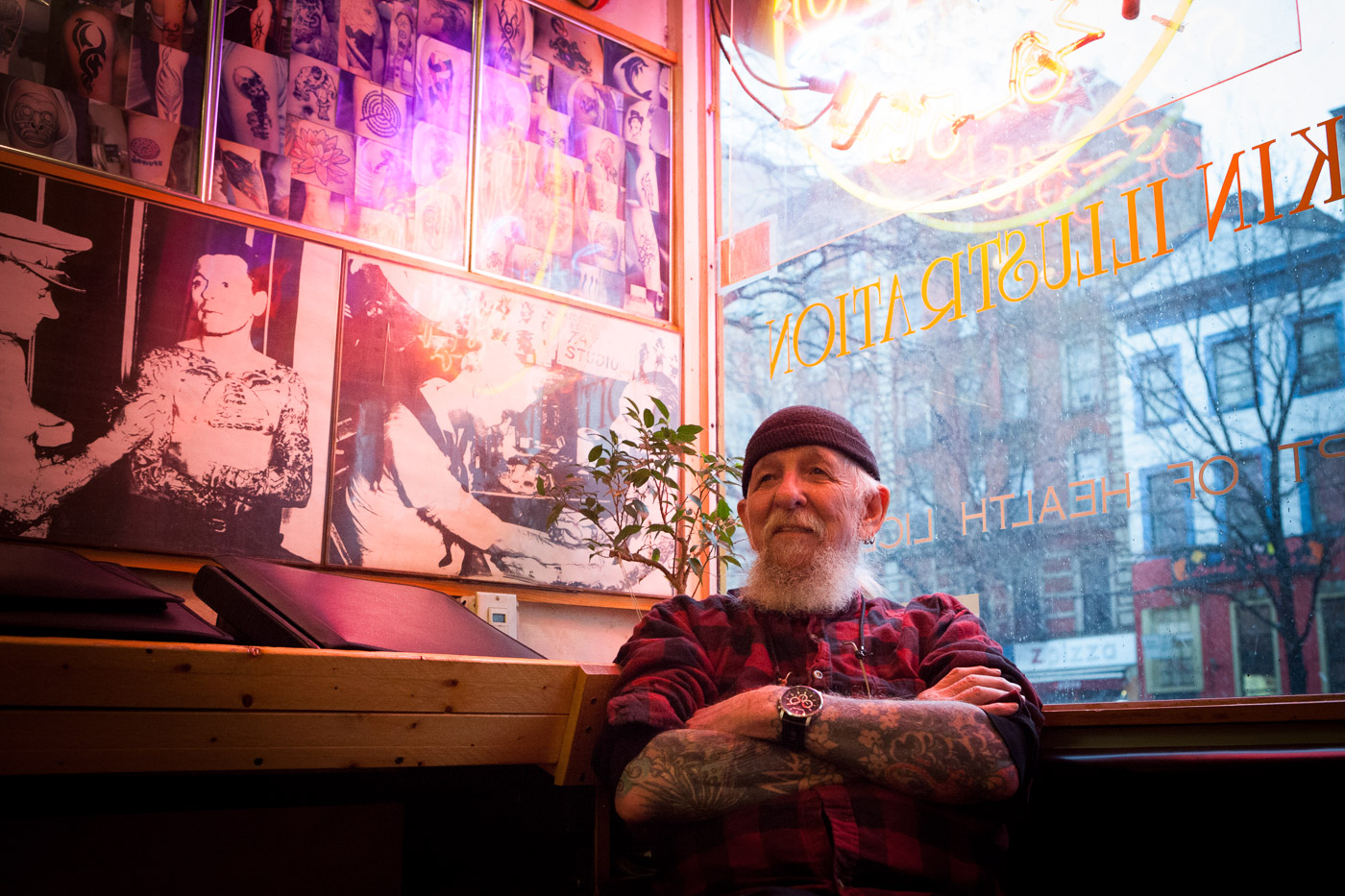Portrait photography is both a difficult and complex genre, whether you are working with businesses, creative portraits, or families. You need to consider a range of technical issues, including location, lighting, time with subject, composition, and even color temperature.
Often you’ll be moving around and changing the lighting on the fly. There is lot of coordination and details to figure out and get right, both through planning and in the moment.
To further complicate things, you need to keep your subject comfortable throughout the entire session, while all the other technical matters are flying through your head. No matter what might be going wrong, your primary attention has to be on engaging the subject.
Getting a subject comfortable is an art form – it can sometimes feel like a therapy session, or dancing on a tightrope. And it’s not always possible to get them comfortable, but with some practice most will come out of their shell if you can work with them the right way.
Here is how I prefer to approach my portrait sessions.
1. What is the Subject Giving You?
Each person will have a certain relationship with the camera. Some will be comfortable – maybe they’ve done this before. Some will be in and out – all business. Some with be naturally comfortable and have a great time. Some will uncomfortable right away, but will open up after they get comfortable with you.

The toughest subjects are those that come in incredibly stiff and uncomfortable. Maybe they had a bad experience with a previous photography, or they hate how they look in photos. Often they’ve been dreading this all day.
These subjects believe they look terrible in photographs, and they know this because they are aware how uncomfortable they get. It’s a catch 22 that you just have to break through.
You have to read each subject and try to figure out a plan to engage with them to get them to open up.
2. Start a Conversation
At the beginning, introduce yourself and start a little small talk. The goal is to make them like you. If they like you, they’ll be more comfortable.
Ask them how their day is going or a similar question. Then, importantly, go through what you will be doing together. Many people are stiff and afraid because they just don’t know what to do and don’t feel confident when you pick up the camera. The more you explain what they should do, the more this fear will go away.

Tell them what you would like from them. Maybe you are looking for casual smiles, natural images, and comfortable poses. Ask them to collaborate with you and give their thoughts. Ask if they have a favorite side of their face to photograph. Is there a way that they feel comfortable standing?
Talk about what type of smile they feel most comfortable with, open or closed mouth, if you want a smile in the photo. Work together to figure out the most comfortable place for their hands.
The most successful shoots are because of a successful collaboration.
3. Posing
Comfort is key to posing. Bad portraits are often do to uncomfortable poses.
Explain to your subject that you will be posing them, but that you also want them to be comfortable in how they stand or sit. Ask them how they might naturally stand, and then fix that pose if needed.
Give them a couple of suggestions. Do they prefer their hands crossed, in their pockets, at their sides, leaning? Then keep them moving. Ask them to try a few different poses that are comfortable.
The hands are the most important element of posing someone. If they have a comfortable way to place their hands then they will most likely start to feel more comfortable. I typically start by giving a few suggestions, then asking to place their hands in a comfortable way.

Then when that pose has run its course, I will ask them to try a different pose and go from there.
Altering the pose to break tension is very important. The second the subject starts looking uncomfortable, you have to do something, so get them to change it up! Move them to a different background. This creates another chance to reset into a comfortable pose.
4. Give Them Praise
Tell your subjects what they are doing right! Positive reinforcement is so important. Never hint that they might look uncomfortable or awkward, or this will make things worse, often to a point that you can’t come back from.
I’m constantly giving affirmations – “This looks awesome” or something more specific.
If someone has a good smile, let them know! Make them feel good about themselves. And if they know what they are doing right, then it will be easier for them to recreate this. You can then say, “Show me that smile that you did earlier.”

Be polite when explaining to subjects how not to do things. Instead of, “Your hands look uncomfortable,” say, “Let’s try putting your hands this way, that may work better.” Constructive comments can be made positively.
5. Prepare conversations and jokes
Just like any social situation, asking questions is the key to getting someone to open up and having a good time, and this is no different when shooting portraits.
As long as the subject doesn’t seem to be in a rush (for business portraits they often are), get a fun conversation going. Try to find something they’re interested in.
Even asking, “Are you from the city” is a great opener. I’ll sometimes try to go a lot further to find a topic that interests them. The more they enjoy talking to me the more they forget they are being photographed.

You don’t need elaborate jokes, but think of some funny things to say when necessary. If a person begins a session by explaining how much they hate being photographed, I might say something like, “Well you’re clearly going to hate me then.” Talking about how they would prefer to be at the dentist will work as well. But I’ll then confidently tell them that they’re in good hands, and just to go with it.
Occasionally when I need a smile, I’ll tell someone to give me their most uncomfortable smile. This I don’t use often but sometimes it works, and I’ll never tell them directly that they look uncomfortable.
Show them the smile you want, and try to get them to smile with their whole body. The shutter click is a very specific moment that the subject is waiting for, but it helps to think of the session as if we were taking video, when they move into and out of their smiles – not just turning them on and off suddenly.

You will have to make tweaks to the poses the subjects give you. Perhaps they need to raise their chin to get rid of a double chin. But making suggestions like this can also ruin the comfort and spontaneity. This is often true when sitting, where the most flattering positions to sit is awkward. So then you will have to try to ask them to look and act as natural as they can, even if the pose necessary feels a little off to them.
I will also have conversational topics for when needed, such as current events, random stories, sports.
6. Use your personality

Maybe you are an extrovert with a lot of charm? In this case you will have an easier time getting your subjects to open up, but you also need to be careful to not overdo it. By commanding too much attention, you risk impending the subject from letting their personality shine through. This often manifests itself in all of the photographs looking the same, with their expressions just about reacting to what you are doing.
If this is you, focus on asking more questions and slowing down to listen more.
Are you introverted and do you get uncomfortable trying to make pleasantries and jokes with the people you are photographing? This is difficult to get over in the early stages o learning, but it can be an advantage when you improve with working with people.
Your advantage here is your ability observe, listen, and react. Ask questions and use your attention to get the right expression.

Be confident or feign confidence and explain what you are doing, but in this case, play a reactive role. Watch videos to learn how a portrait photographer interacts with subjects.
The of ice breakers and funny stories ahead of time, as this will be an initial disadvantage. You will need to work harder at first to catch up, but eventually the advantages will swing back in your favor.
7. If you can avoid it, never show the photos while shooting
Often subjects will insist on seeing the photos as you are shooting, but I always try to get out of this until the end or until we’ve gotten a good portion of the way through and I’ve got a lot of what I want.
I might ask if we can look at the images a little later after we’ve done a little more with them comfortable. On one hand they can tell you what they don’t like about themselves in the photos, but say the keeper rate for these portrait settings are 2/10. That means they’ll be seeing a ton of the bad photos while scrolling through, which could make them more self-conscious once you get back to shooting. And it’s tough to come back from that.

And for the most uncomfortable subjects, often the beginning photos won’t be very good. You go through the early motions as you work to get them comfortable, and once you do then you run with it. Showing the subject these early photos might not given them much confidence in you going forward.
8. You can’t win them all
You will lose a few. You can only do so much with what you are given.
Knowing this will help you reduce the stress. Just do your best and be proud of that, because there are some subjects that won’t be good no matter how hard you try.


Great tips! Learned a lot thanks!